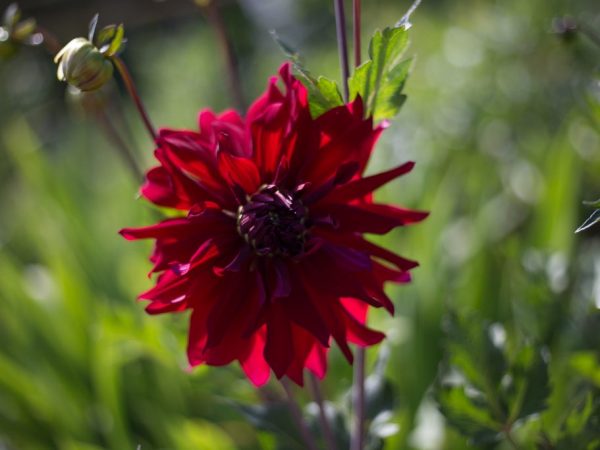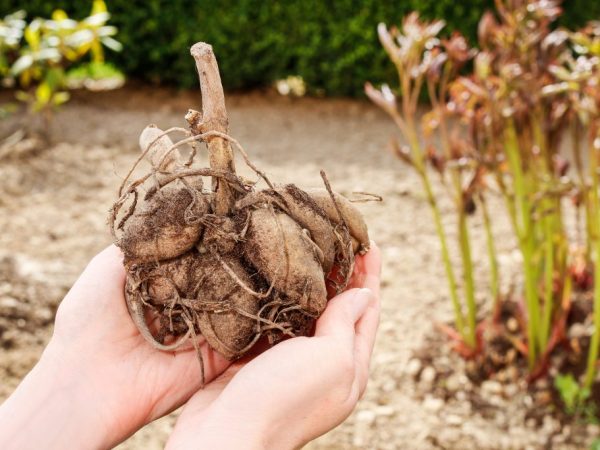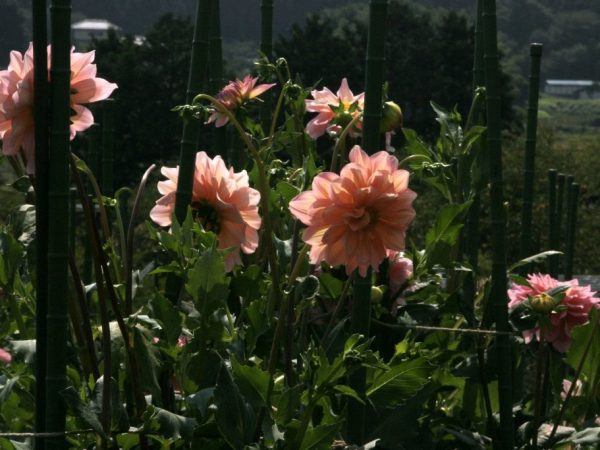Rules for caring for dahlias in the fall
Caring for dahlias in the fall includes all the necessary measures to keep them healthy until spring. The peculiarity of preparing for winter is the mandatory digging of the bulbs and laying them for storage, because this flower culture, although perennial, dies in the soil in winter from low temperatures.

Rules for caring for dahlias in the fall
Necessary activities
First of all, in the fall, care is needed for the area where dahlias are grown. It needs to be prepared for winter:
- remove leaf litter;
- to clear from weeds and debris;
- huddle ridges;
- fertilize;
- dig up tubers.
Site cleaning
Careful cleaning of the remaining leaves, weeds and debris avoids the preservation of pathogens and pest larvae in the soil, which overwinter in decaying remains and are activated in the spring when the heat comes.
They pick up the landing site 2 weeks before the planned date of digging out the dahlias, because low air temperature in autumn makes flowers most susceptible to infection by infectious diseases, which should be excluded before laying for winter storage.
Hilling and pruning rules
Hilling in the fall is carried out to protect the root system of not yet dug out flower bushes from sudden frosts. This is done from late August to early September. The height of the hill is formed up to 10-12 cm near the stems.
After flowering, dahlias are pruned to 15 cm in order to redirect the flow of nutrients to the tubers.
Each bush is marked with a tag with a variety so as not to be confused when planting.
Watering
Bulbs require a lot of moisture before wintering. This will protect the root tubers from drying out during storage. It is necessary to water the bushes taking into account the autumn weather and the speed of drying of the soil, because stagnation of water in the soil leads to the beginning of decay of the root collar and root tubers.
In case of continuous and prolonged rains, the plantings are covered with a moisture-proof shelter to reduce the penetration of moisture to the roots.
The basic rule is to stop watering 1-2 weeks before the planned date of digging out the flower bushes.
Top dressing
The main task of autumn dressings is to increase the content of potassium and phosphorus, which are responsible for the overall frost resistance of the flower.
Nitrogen is not introduced in autumn, because it stimulates the growth of green mass and shoots - which is superfluous in preparation for winter.
It is necessary to apply fertilizers before the end of August. Residents of southern regions with warm climatic conditions have the opportunity to postpone these dates to early September.
The best food for a flower culture in the fall will be a mixture of potassium sulfate and superphosphate (1 tsp per 10 liters of water). The consumption rate of the working solution for irrigation is 2-3 liters for each plant.
When and how to dig a dahlia

Flowers are dug up at the end of September
In southern climatic zones, where the ambient temperature in winter does not drop below -5 ° C-7 ° C, dahlias are left to winter in the open ground.In the least climate-friendly regions, dahlias are dug up in the fall.
But with such a wintering, they are subject to compulsory shelter: the ground is covered with mulch. The protective layer of their coniferous spruce branches and bark should be at least 5-10 cm.
Neither peat nor compost is used as mulch, which, at positive temperatures, will provoke rotting of the root collar.
Timing
Time depends on regional characteristics:
- in the Urals - from the last days of September;
- in Siberia - from the end of August;
- in the middle lane, including the Moscow region - from October.
When choosing the timing for digging up a flower culture, they are guided by the appearance of the plant: the root tubers are ready to be laid for injury when the leaves of the bush have turned yellow and withered.
Not worth it:
- Dig up dahlias ahead of time, while flowering continues and while the foliage remains green. The green mass that has retained its vitality through photosynthesis helps the flower to accumulate as many useful elements as possible in the roots, which will increase the shelf life of the bulbs.
- Leave the plants until the final onset of frost, when sub-zero temperatures are observed not only for a short time at night, but also in the daytime. Freezing leads to decay of the root collar and shortens the shelf life of the planting material.
When choosing the golden mean for digging out root tubers, they monitor the condition of the bush: as soon as it begins to dry from the first night cold snaps, it means that the tubers are ready. The grower has 2-3 days to prevent spoilage.
Training
Before digging a flower culture in order to bookmark it for winter storage, it is necessary to inspect it for the presence of damaged by pests and affected by infections. Plants with signs of disease are dug up and immediately destroyed in order to avoid the spread of pathogens to healthy flowers.
Symptoms that should alert you:
- white bloom - symbolizes the presence of fungi;
- brown spot - indicates rotting;
- premature drying of the vegetative mass (stems and leaves) - indicates infection with a fungal or bacterial infection.
Weakened, non-viable dahlias with too long or fragile stems, as well as those that have not bloomed so much in the current season, are subject to rejection. Such specimens, even if stored until spring, are most likely not to bud next year.
Technology

Choose healthy plants for planting next year
- Uncircumcised and newly regrown shoots and leaves are cut with pruning shears;
- The bush is undermined along the perimeter, retreating 0.3 m from the growth site for medium-sized plants and increasing the radius for larger ones, this is necessary so as not to damage the root system;
- Root tubers are taken out by prying with a pitchfork, without pulling out the remains of the tops;
- Cleared from a larger share of the land so that it is possible to inspect for the presence of rot, damage;
- fragments that are insignificant in area are cut with a knife;
- Weak thin roots are cut with pruning shears, the cuts are sprinkled with crushed activated carbon or wood ash;
- Spread out to dry naturally.
For storage, those tubers are taken that, after sanitary cleaning, have retained up to 2/3 of the total volume.
How to keep dahlias until spring
Before laying for the winter, the bulbs are disinfected. This is done by treatment with potassium permanganate or antifungal agents.
Many growers prefer to split the rosette in order to prevent contact and timely protect against the spread of rot throughout the planting material. In this case, only large root tubers can be divided.
It is possible to save dahlia bulbs until spring in an apartment or in a basement in different ways:
- in containers with sand or sawdust;
- by wrapping in a newspaper or film;
- dipping in paraffin, which creates a protective layer.
For home storage, planting material can be decomposed in the refrigerator, but away from vegetables and fruits.
To preserve the root tubers of dahlias, it is not recommended to put them in unventilated plastic bags that do not conduct air and cause rotting.
Optimal conditions:
- temperature 4 ° C-9 ° C;
- humidity - up to 60%.
Summing up
Dahlias should be taken care of not only during the summer, when they are actively blooming, but also in the fall, before the plants begin to dormant in preparation for wintering. Leaving root tubers in the open field can only be gardeners of the southern regions, where winters are relatively warm.
In other climatic zones, in order to avoid freezing of the root system, the bulbs are dug up and stored until planting in the spring.

